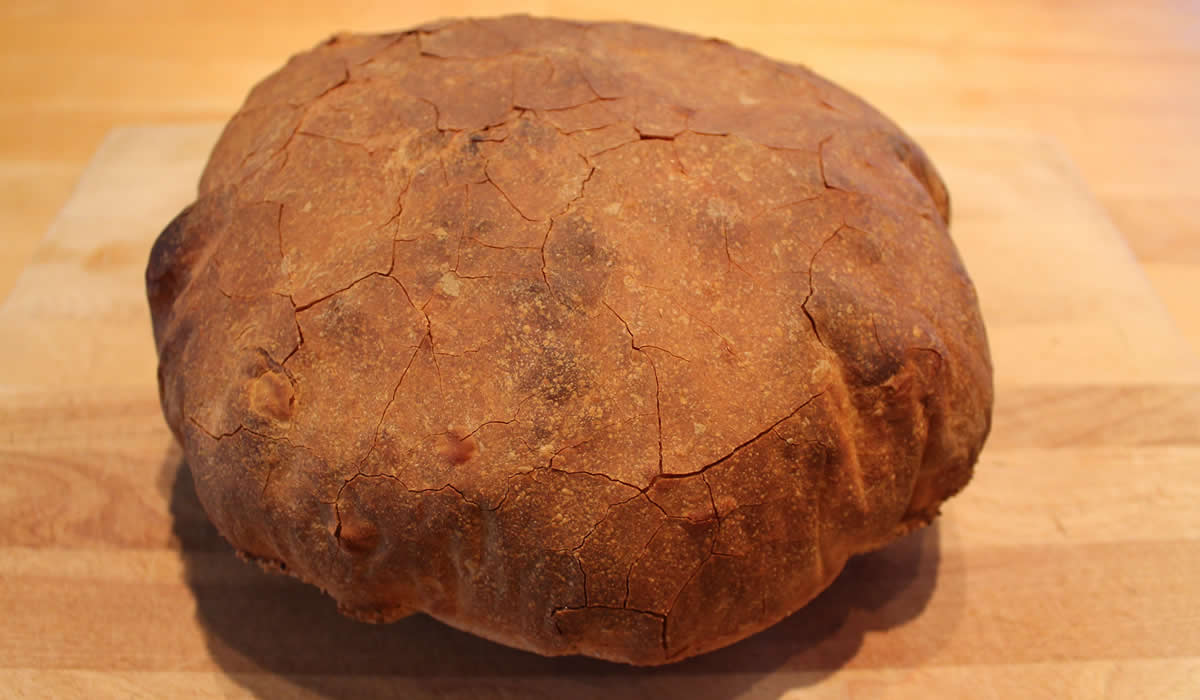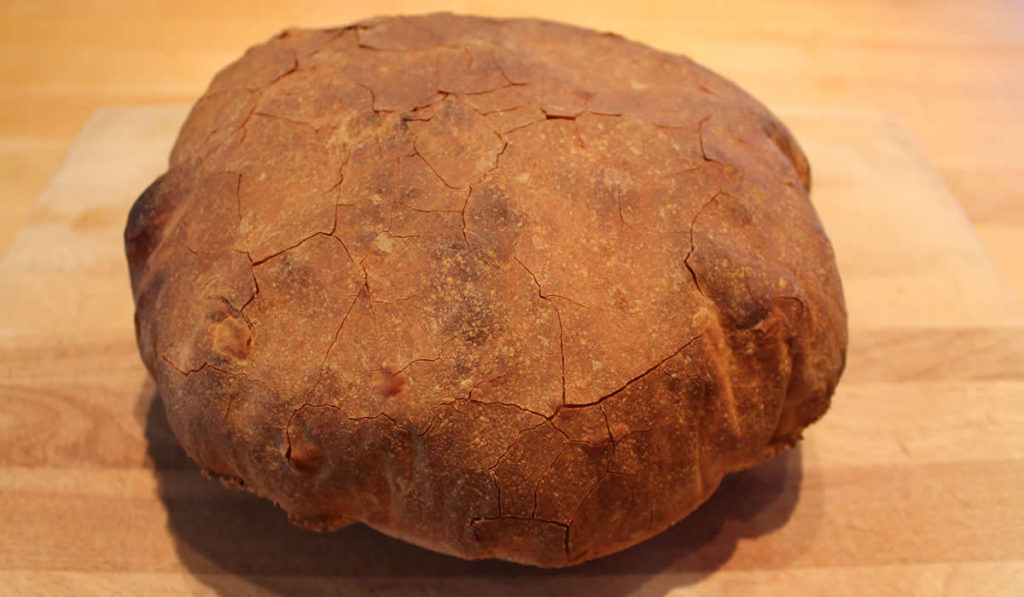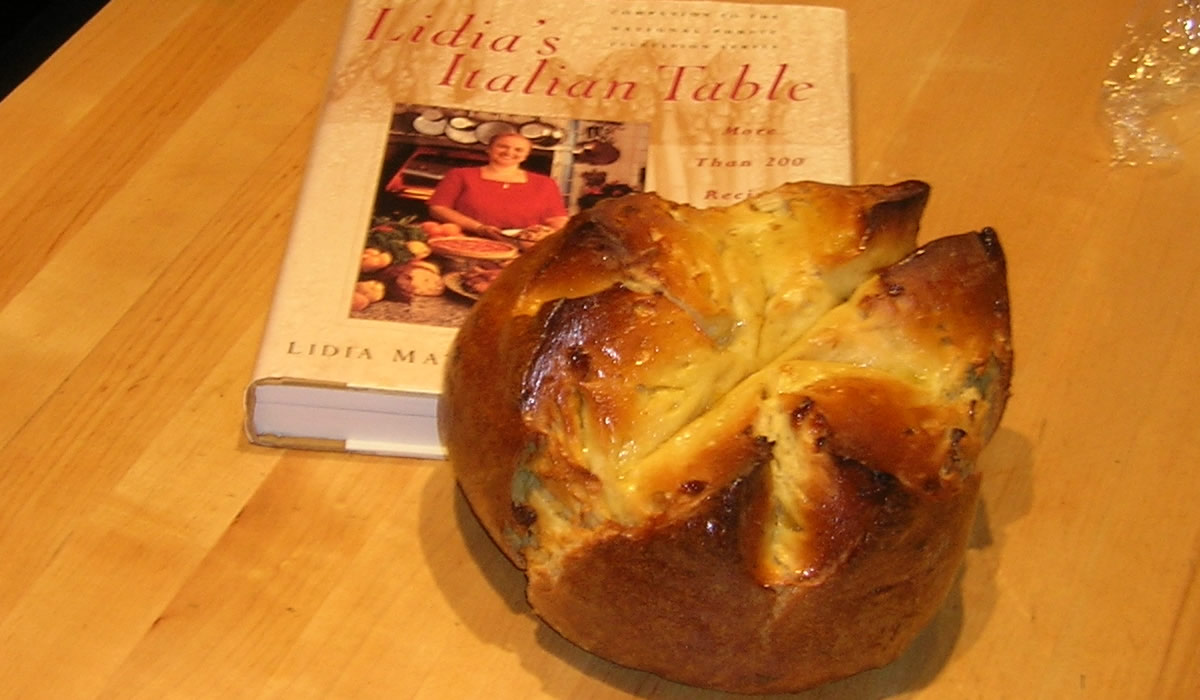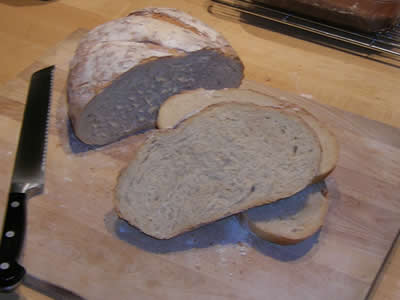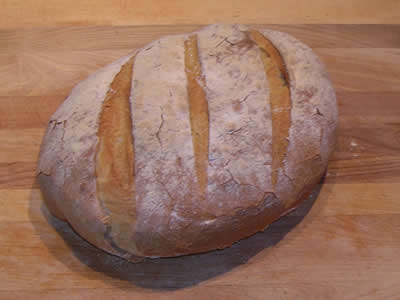Italian Bread
In one of my rare TV-viewing moments, I caught an episode of Modern Marvels on the History Channel. It was all about bread making. It showed Wonder Bread being made (the first sliced bread - who knew?!?) as well as every conceivable bread, from cornbread to pitas to tortillas to Ethiopian injera, bagels, San Francisco sourdough, braided challah, and artisan breads of every stripe. It made me want to bake bread. But, it was 8pm when the show ended. It was a bit too late to start baking - but not too late to make a biga - an Italian starter.
So... into the kitchen I headed and pulled out my trusty copy of The Italian Baker. I picked up this book sometime in the 1980's and have carted it around forever - mostly for one recipe of Pane Pugliese. It's a great rustic bread made with flour, water, and salt. It's amazing the amount of flavor that can come from such simple ingredients. The secret, of course, is the Biga!
Biga is classic starter that produces a natural flavor and fantastic aroma. Once upon a time, I always had a starter in my refrigerator. I even had a sourdough starter I got from my mom who had had hers for years. I'd love to have THAT right now... Unfortunately (stupidly!) I got rid of it for one reason or another, figuring I could always get more from Mom. When I finally decided I wanted it, again, she no longer had hers. But I digress...
The classic Biga recipe:
- 1/2 tsp active dry yeast
- 1/4 cup warm water
- 1 1/4 cup water (room temperature)
- 3 3/4 cups unbleached all-purpose flour
Stir the yeast into the warm water and let stand until creamy - about 10 minutes. Stir in the remaining water and then the flour, one cup at a time.
Mix with the paddle attachment on the mixer at the lowest speed about 2 minutes.
Remove to a slightly oiled bowl, cover, and let rise at cool room temperature for 6 to 24 hours. The starter will triple in volume and still be wet and sticky when ready. Cover and refrigerate until ready to use.
Tomorrow after work, I'm making the Pane Pugliese. It should be ready by this time tomorrow!
Italian Easter Bread (Pinza)
Having never made something before has never stopped me from 1) making it, and 2) serving it to a large gathering of people. My thought process is the worst thing that can happen is it's inedible and I throw it away. Since that really hasn't happened in 30 or so years, I don't worry about it.
And on that note, I started making Lidia's Easter Bread. Her Pinza.
I love Lidia's cooking. For the most part it is simple mixing of simple flavors to get anything-but-simple results. But every once in awhile she throws a curve-ball. And the Pinza is one...
Reading through the recipe, I realize that this is going to be a process. I didn't have the probably 12 hour stretch the bread needs to make, so I figured I'd break it up over a couple of days. It worked, more or less (actually, the flavor of the bread came out fantastic!) but I do think that I 1) needed more yeast, and 2) really should have let it rise more.
The recipe calls for 4 ea 3/5 oz cakes of fresh yeast or 4 ea 1 oz packages of dry yeast. Basic dry yeast comes in 1/4 oz packages and I haven't used fresh yeast in 45 years - since I worked at The Donut Center. Having done a considerable amount of baking in my time, I thought that even using 4 packages of yeast for three loaves of bread was a lot. I figured the 1 oz was a typo. But I put in 4 packages, nonetheless.
So... Friday after work I started the bread. It doesn't take much work, but there is a lot of wait time. At $3.50 a gallon for heating oil, our house is not exactly a baker's paradise. It easily took 2 1/2 hours for the first risings. I completed the next step - the 5 cups of flour, and then placed it in the fridge. (It was late and I didn't want to leave it out overnight. I probably should have...)
When I got home from work on Saturday, I took it out and started where I had left off. Again, not the warmest place in town. It took forever just to reach room temperature. It sat out while we all colored eggs.
I finally got it formed into the three balls and late Saturday night and it went back into the fridge. Early Sunday morning, it was back out, again.
I made the traditional cuts along the top and set it out to warm and rise. I turned on the heat, I turned on the oven. I set them in the sun. S-L-O-W-L-Y they were rising. Very slowly. They had not completely doubled in size when I had to get them in the oven. We had to be at Steve and Marie's at 2. It was 12:30pm. The bread had been out for almost 6 hours.
They came out delicious! Having never made them before, I still don't know exactly how they should have turned out, but I do think they should have been a bit lighter. They were absolutely wonderful the way they were, but... I don't think they were quite right. Folks raved about it and everyone was going back for more so I know it wasn't folks just taking a 'polite' piece - they really did like it!
I'm going to make it again one of these days - when I have the time to complete them start-to-finish in one day.
I'll let ya know how they come out!
Easter Bread
Lidia Matticchio Bastianich
- 1 1/2 cups golden raisins
- 1/2 cup dark rum
- 1 cup milk
- 1 cup granulated sugar plus 2 tablespoons
- Four 3/5-ounce cakes fresh yeast, crumbled (1/3 cup), or four 1-ounce packages instant dry yeast
- 9 cups unbleached all-purpose flour, or as needed, sifted
- 3 large eggs, at room temperature
- 6 large eggs yolks, at room temperature
- 1/2 cup (1 stick) unsalted butter, at room temperature, plus more for the bowl of dough
- 1/2 cup Vin Santo, Verduzzo, or other sweet white wine
- Grated zest (yellow part only, without the underlying white pith) of 2 large lemons
- Grated zest (orange part only, without the white pith) of 1 orange
- 1 1/2 teaspoons salt
- 2 teaspoons pure vanilla extract
- 2 tablespoons water
Combine the raisins with the rum in a small bowl and toss to mix. Let soak, tossing occasionally, while preparing the bread.
In a medium-size saucepan, heat the milk over medium heat to lukewarm, about 100°F.
Pour the warmed milk into a large bowl and add 1/2 cup of the sugar and the yeast. Stir until they are dissolved. Add 1 cup of the flour and stir until the mixture is smooth.
Cover the bowl with a kitchen towel and let it rise in a warm, draft-free place (such as on top of the refrigerator or in a gas oven with the pilot light on) until frothy. (If it doesn’t get frothy, that means the yeast is no longer active and you will have to start again with fresh yeast.)
Stir the dough with a fork to deflate it, then let it rise and froth two more times, stirring it down thoroughly and covering it again after each time. Depending on the environment, these three risings can take from 20 minutes to 45 minutes each.
In the bowl of a heavy-duty electric mixer fitted with the paddle attachment, whip 2 of the whole eggs, 2 of the yolks, and the remaining 1/2 cup sugar together at medium speed until foamy and pale yellow.
Add 1/4 cup (1/2 stick) of the butter, the wine, zests, salt, and vanilla. Beat until only small pieces of butter remain. Scrape the yeast mixture into the mixer bowl and beat until blended. Change to the dough hook attachment of the mixer and reduce the speed to low.
Add 5 cups of the remaining flour, 1 cup at a time, beating until the mixture forms a sticky dough. Wait for each cup of flour to be incorporated before adding the next and stop the machine occasionally to scrape any unmixed ingredients from the sides and bottom of the bowl into the dough. The dough will be quite sticky; form it into a rough ball, clean the sides of the bowl, and cover the bowl with a kitchen towel. Let the dough rise in a warm, draft-free place until doubled in bulk, 1 to 2 hours.
Return the bowl of dough to the mixer fitted with the dough hook.
Mix the dough at medium-low speed until deflated. Add the remaining 4 egg yolks and 1/4 cup (1/2 stick) butter and beat until incorporated. Gradually add enough of the remaining flour — about 2 cups — to form a firm but slightly sticky dough, stopping the mixer occasionally to scrape any unmixed ingredients from the bottom of the bowl into the dough. Add the raisins and rum and mix until incorporated. Dough will be quite wet and sticky at this point.
Turn the dough out onto a well-floured surface.
Knead the dough, adding as much of the remaining 1 cup flour as necessary to prevent the dough from sticking to your hands and to the table, until the dough is smooth, soft, and only very slightly sticky if left to rest a minute.
Place the dough in a large lightly buttered bowl and turn the dough to butter all sides of it.
Cover the bowl with a kitchen towel and set the dough to rise in a warm, draft-free place until doubled in bulk, 1/2 to 2 hours, depending on the environment.
Turn the risen dough out onto the floured work surface and knead until deflated.
Cut the dough into three equal pieces and knead each into a ball, gathering and pinching the seam side of the dough together to form as smooth a ball as possible. (These formed loaves can be tightly wrapped in plastic wrap and refrigerated overnight. Allow extra time for refrigerated loaves to rise in the following step.)
Line two baking sheets with parchment paper.
Place two loaves on one of the baking sheets, leaving as much space between them and the edges of the pan as possible. Place the third loaf in the center of the other baking sheet. With a pair of kitchen scissors, make three 1 1/2-inch-deep, 3-inch long intersecting cuts that meet at the center to form a six-pointed star pattern on the rounded top of each loaf. The cuts should be quite deep — at least halfway through the loaf — to allow the dough to rise up from the center and form the traditional crests on the loaf.
Cover the loaves lightly with kitchen towels and let rise in a warm, draft-free place until doubled in bulk, 1 to 2 hours.
Preheat oven to 325°F.
Bake the bread for 35 minutes. Whisk the remaining whole egg with the remaining 2 tablespoons sugar and the water until very smooth and the sugar is dissolved. Brush the pinze with this egg mixture, return them to the oven, and continue baking until very deep golden brown and a knife inserted into the center of the loaves comes out clean, about another 20 minutes.
Cool the pinze completely on a wire rack before slicing.
French Country Bread
It's cold outside. in fact, not only is it cold outside, but ice has been falling from the sky since yesterday. Welcome to the mid-Atlantic states. It's a mess out there. Not as bad as upstate New York - or Cleveland - but a mess all the same.
Last night, knowing that today was going to be spent indoors, I decided I needed to warm up the house by baking bread. Searching through recipes, I found one for a French Country Bread. It calls for making a sponge the night before baking, so last night I did just that...
Once upon a time I had a sourdough starter that had to have been older than me. It was an original wild yeast starter. I carried it around for years, feeding it, using it. It was great because I could really make bread whenever I wanted, and back in my youth I did bake a lot more bread than I do today. Part of it was the times, part of it was financial. Baking bread is cheap. I have no idea where it finally ended up, but it really made a great loaf of bread. The one I made last night calls for packaged yeast and would shock the purists, but heck - it's still a homemade loaf of bread, not squishy-white from the grocery store!
This particular bread is made with both whole wheat and white flour and has no oil or fat, so it's basically a use-the-day-you-bake-it bread.
The basic recipe is:
French Country Bread
Sponge:
• 1/2 cup wheat flour
• 1/2 cup bread flour
• 1-1/2 teaspoons active dry yeast
• 1/2 cup water
• 1-1/2 teaspoons dark corn syrupCombine the two flours and the yeast in a mixing bowl. Add the water and corn syrup and stir until well blended. Cover with a kitchen towel and allow to stand at room temperature overnight.
To prepare the dough:
• 3/4 cup water
• 1-1/2 teaspoons salt
• 3/4 cup wheat flour
• l-1/2 cups bread flourAdd the water, salt and wheat flour to the sponge. Stir in the bread flour, adding an extra tablespoon or two if the dough seems sticky. Knead until smooth and elastic, about 8 minutes. Place the dough in a greased bowl and cover with plastic wrap. Let rise until doubled in size, about 1 hour and 45 minutes.
When the first rise is complete, punch the dough down. Shape into a ball or an oval. Flatten slightly. Place on a greased baking sheet that has been sprinkled with cornmeal. Cover with a kitchen towel and let triple in size - 2 to 2 1/2 hours.
Place an empty pie plate on the bottom oven shelf. Preheat the oven and the pan to 425 degrees. Five minutes before adding the bread, carefully pour 1 cup hot water into the pan. Careful here! This causes a big burst of steam!
Sprinkle the loaf with flour, and Using a sharp knife, cut 3 diagonal slashes across the surface of the loaf. Bake 30 to 35 minutes, until golden brown. Remove from the pan and cool.
The bread is on its first rise right now... More details to follow.....
What a great bread! It has an extremely delicate crumb. Soft and moist, with a great chewy, crusty crust! Perfect for dipping into soup or stew, slathering butter, or making hefty sandwiches. it was incredibly easy to make, too.
I shall be making this, again. And again.

